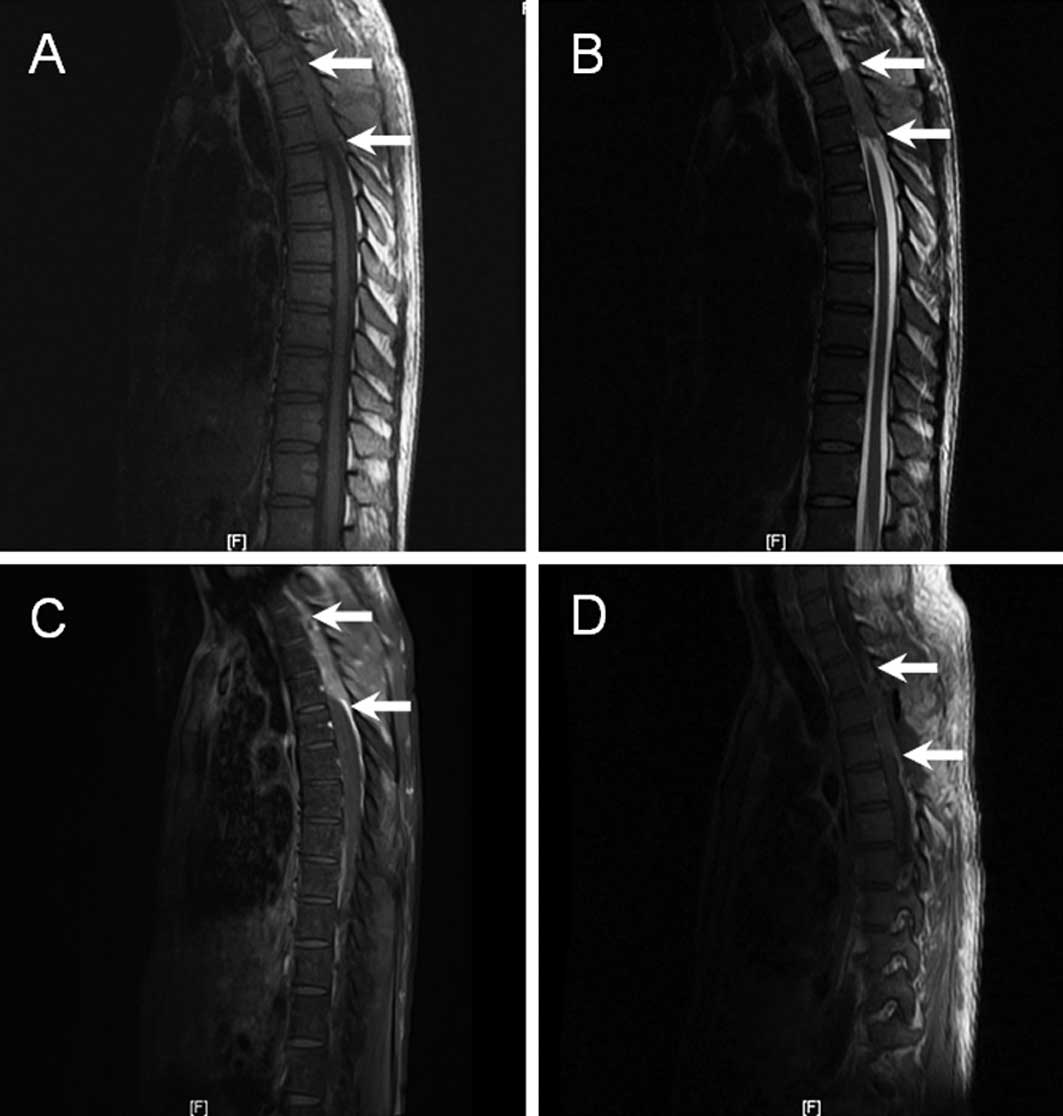Successful bortezomib treatment in combination with dexamethasone and thalidomide for previously untreated epidural plasmacytoma
- Authors:
- Zhiyong Zeng
- Ling Zheng
- Junfang Lin
- Junmin Chen
View Affiliations
Affiliations: Department of Hematology and Rheumatology, The First Affiliated Hospital of Fujian Medical University, Fuzhou 350005, P.R. China
- Published online on: December 28, 2011 https://doi.org/10.3892/ol.2011.539
-
Pages:
557-559
Metrics: Total
Views: 0 (Spandidos Publications: | PMC Statistics: )
Metrics: Total PDF Downloads: 0 (Spandidos Publications: | PMC Statistics: )
This article is mentioned in:
Abstract
Epidural plasmacytoma is a rare clinical entity of plasma cell neoplasms. The optimal management of extramedullary plasmacytoma remains unclear, particularly for bulky masses. In this study, we report the case of a 35-year-old male who presented with the inability to walk, urinary incontinence and superficial and deep sensory disturbance. Spinal magnetic resonance imaging revealed a large epidural mass compressing the spinal cord at the level of T2-T4. The patient underwent surgical T2-T4 vertebral canal decompression. Histopathological examination and other findings confirmed the diagnosis of extramedullary plasmacytoma. The patient was treated with bortezomib in combination with dexamethasone and thalidomide. Following 4 cycles of chemotherapy, the patient achieved an excellent clinical response. Over 1 year following the initial diagnosis, the patient was in complete remission with no evidence of local relapse or evolution to multiple myeloma. This is the first case of a previously untreated epidural plasmacytoma, which was successfully treated with bortezomib-containing chemotherapy.
View References
|
1
|
Kyle RA and Rajkumar SV: Multiple myeloma.
Blood. 111:2962–2972. 2008. View Article : Google Scholar : PubMed/NCBI
|
|
2
|
Okacha N, Chrif E, Brahim E, et al:
Extraosseous epidural multiple myeloma presenting with thoracic
spine compression. Joint Bone Spine. 75:70–72. 2008. View Article : Google Scholar : PubMed/NCBI
|
|
3
|
Zazpe I, Caballero C, Cabada T, Guerrero
D, Gallo-Ruiz A and Portillo E: Solitary thoracic intradural
extramedullary plasmacytoma. Acta Neurochir (Wien). 149:529–532.
2007. View Article : Google Scholar : PubMed/NCBI
|
|
4
|
Soutar R, Lucraft H, Jackson G, Reece A,
Bird J, Low E and Samson D: Guidelines on the diagnosis and
management of solitary plasmacytoma of bone and solitary
extramedullary plasmacytoma. Br J Haematol. 124:717–726. 2004.
View Article : Google Scholar
|
|
5
|
Tsang RW, Gospodarowicz MK, Pintilie M,
Bezjak A, Wells W, Hodgson D and Stewart A: Solitary plasmacytoma
treated with radiotherapy: impact of tumor size on outcome. Int J
Radiat Oncol Biol Phys. 50:113–120. 2001. View Article : Google Scholar : PubMed/NCBI
|
|
6
|
Galieni P, Cavo M, Pulsoni A, et al:
Clinical outcome of extramedullary plasmacytoma. Haematologica.
85:47–51. 2000.
|
|
7
|
Holland J, Trenkner DA, Wasserman TH and
Fineberg B: Plasmacytoma. Treatment results and conversion to
myeloma. Cancer. 69:1513–1517. 1992. View Article : Google Scholar : PubMed/NCBI
|
|
8
|
Espanol I, Martinez A, Lopez MD, et al:
First report of a medullar cord compression secondary to osseous
plasmacytoma successfully treated with bortezomib and
dexamethasone. Leuk Res. 34:E97–E99. 2010. View Article : Google Scholar
|
|
9
|
Laura R, Cibeira MT, Uriburu C, Yantorno
S, Salamero O, Blade J and Montserrat E: Bortezomib: an effective
agent in extramedullary disease in multiple myeloma. Eur J
Haematol. 76:405–408. 2006. View Article : Google Scholar : PubMed/NCBI
|











